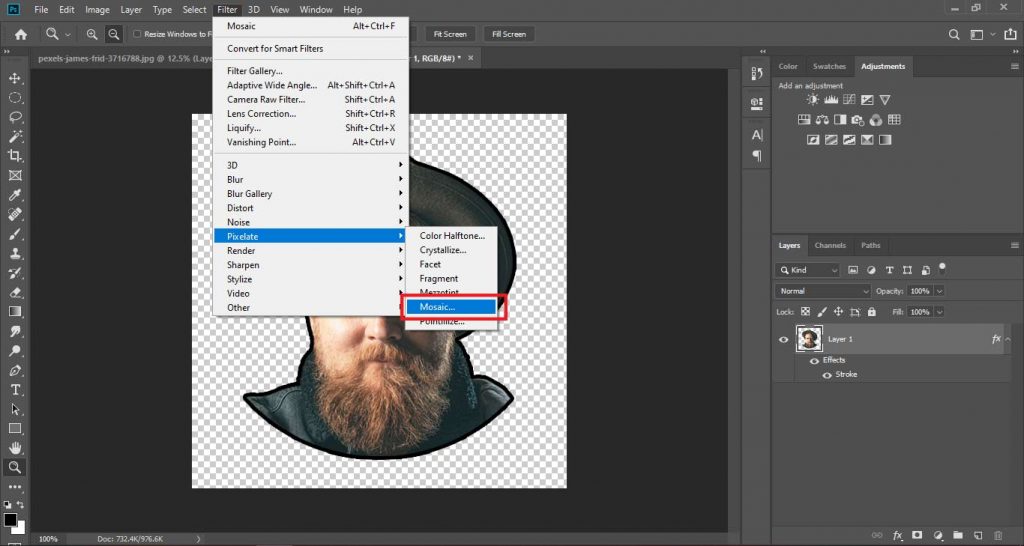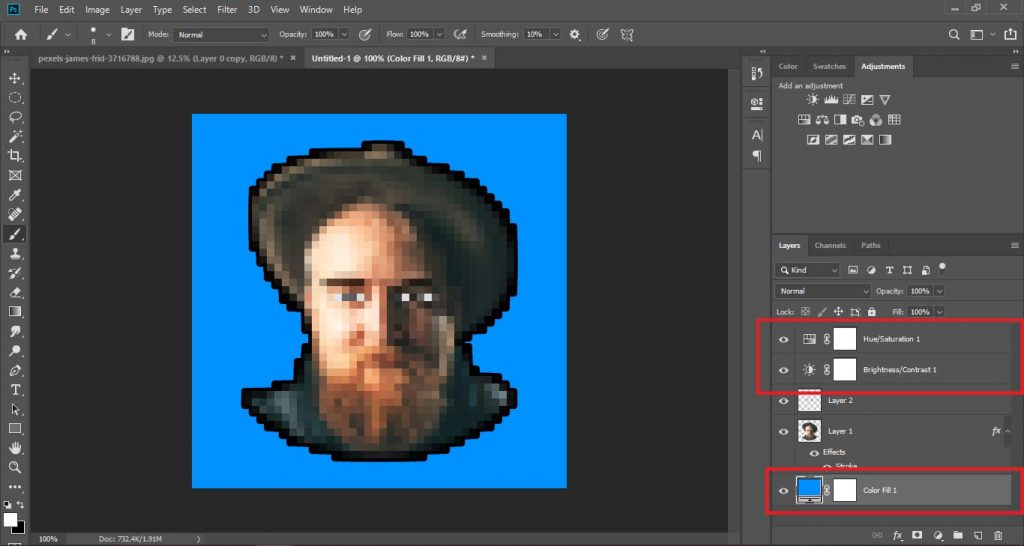How to Make High Quality Pixel Art in Photoshop
Most of the time we demand high-quality pictures and portraits but sometimes we need some pixelated moving picture to apply in our design or we just need pixel art of any film of us. I am going to bear witness you the exact method of how to make pixel art Photoshop of whatsoever object or portrait from whatever pic.
Now yous've captured your picture show and you wanted to make it pixelated look like old fun, retro, 8-chip pixel art.
In this situation, we have Photoshop to convert pictures into pixel art Photoshop makes them pixelated.
If you wanted to larn how to catechumen pixelated logos or icons to high-resolution icons then, click here!
At present if y'all wanted to acquire the complete technique to brand this pixel art in Photoshop, you just have to stick with me through the end of the commodity.
Considering in this article, I'll evidence you the ultimate step-past-step guide virtually how to make pixel art Photoshop and make anything like fun, retro, 8-bit erstwhile pixelated prototype.
Step 1: Setting Up a Pixel Fine art File
In Photoshop, go toFile > New. Proper noun the document of your choice.Ready the file to the following dimensions:
- Width to 500 px
- Elevation to 500 px
- Orientation toLandscape
- Resolution to 50
- Colour Mode toRGB
Then clickCreate.

Pace 2: Open Motion picture Of Subject
Open a photo of someone or something that yous'd like to use for this project. To practice that just drag and drib the moving-picture show of the subject on your certificate or y'all can go to File > Place Embedded.

This volition inquire y'all to get to the location of the motion-picture show and open it.
The beginning step is to re-size it, to become the results we want.
If y'all'd like to crop the bottom of your subject into a circular shape, open your Elliptical Marquee Tool, go near a corner, and printing and concord the Shift key as you elevate a circular selection over it.
Nosotros'll cut out our subject inside the option by pressing Ctrl or Cmd + J to make a duplicate of the choice and we can now just hide the bottom layer.
Click the eyeball icon next to the bottom layer to hibernate it.
Step 3: Background Removal
Side by side, nosotros'll delete the residual of the background behind our subject and mask your subject.
There are many ways to practise this and your method should depend on the characteristics of your photograph.
For this example, if the background is pure white or any one color, you can use my Magic Wand Tool.
Yous can make the Tolerance x and make sure "Contiguous" is checked. "Face-to-face" will ensure that but the white area outside my subject will be selected.
So I have different types of selection tools in Photoshop and some of them also use AI to consummate selections.
- Rectangular Marquee: You tin can select rectangular portions of an image with this tool.
- Lasso: This option tool allows you to draw your own freeform outline of what you wish to select. This works best for those areas that don't qualify as shapes.
- Quick Selection: This tool is used like the lasso tool except it works all-time on an area with clearly defined edges. You drag the mouse and the outline "snaps" to the edges.
You tin utilize Quick Selection tools to do the selection and if y'all want to exist perfectly accurate about selections y'all can use Pen Tool to do that.
Just how to make selections is not the tutorial then we should non waste product time learning how to select objects.
Use any of the option tools you want to use and make a selection of groundwork and then only press delete on the keyboard to delete the background from the subject.

In society to deselect it, press Ctrl or Cmd + D on your keyboard.
Footstep four: Adding Stroke
Now we have to add a black stroke around our subject field to get in more than look like 8-flake retro pixel art only it all depends on you.
Yous can skip this footstep of applying the stroke.
To add a stroke right click on the subject field layer and select Blending Options.

At present in the blending pick select Stroke and in the stroke settings.
Ready the color to blackness, the Size to 5 pixels, and the Position to "Outside". Then, click OK or press Enter or Render.
Step 5: Converting to Pixel Art Photoshop
Now we take to utilise our filter to make the image pixelated. Merely earlier nosotros'll catechumen our paradigm to pixel art, we have to catechumen our epitome into a Smart Object, then we tin add filters and additional adjustments to it non-destructively.
To practise this, right-click on the subject layer from the Layers panel and click "Catechumen to Smart Object".
At present nosotros can employ Filters not-destructively, and so go to Filter > Pixelate > Mosaic.

Brand the Cell Size 10 square or you tin use whatever value y'all desire according to your preference.
Stride vi: Calculation Features to Pixel Fine art Photoshop
As you can see we have our pixel art almost gear up but we take to add a feature if our portrait or object needs to be shown correctly.
Next, we'll add blackness and white squares to accentuate certain features of our character. I'll show you 2 ways of doing information technology.
Start, I'll show you lot how to do it if you're using a version earlier than CC. Then, I'll testify how to do it using CC or afterwards, which has a precise method.
Before Than Photoshop CC:
If you're using a version earlier than CC, create a new document by pressing Ctrl or Cmd + N or get to File and New. Make the Width and the Tiptop x pixels each and the Resolution, 50 pixels per inch. The colour is blackness. Then, click "Create" or "Open up".
To meet it onto your sheet at its maximum size, printing Ctrl or Cmd + 0. Go to Edit and "Define Brush Preset". When this window appears, simply click OK.
Open dorsum your pixel art document. Irrespective of the version you're using, allow's remove the lightest squares along the edge of your character.
Go to Select and "Colour Range". Choose "Highlights". Make the Fuzziness is 0% and the Range is 1.
Click the Layer mask icon to make a layer mask of the selection next to the active layer.
Nosotros'll brand a new layer below the active layer, by Ctrl-clicking or Cmd-clicking the New Layer icon. We'll use this layer as the groundwork.
For now, let'south fill it with white, and since white is our background color, printing Ctrl or Cmd + Delete. Click the top layer to make it active and make a new layer to a higher place it.
For versions earlier than CC, open your Pencil Tool and Pencil Picker. The final thumbnail is the preset nosotros saved earlier.
Click it to make it active and brand sure its Opacity is 100%.
This start method requires great care in aligning it straight over the foursquare nether it.
If it's non aligned exactly, press Ctrl or Cmd + z to disengage the last pace and attempt once again.
To make your brush white, printing "10" on your keyboard to invert your foreground and groundwork colors.
Photoshop CC or Afterwards:
For those who are using CC or later on, go to View and "New Guide Layout". In the Columns and Rows, type in 50 pixels each and keep everything else unfilled and unchecked.
If you don't see the guidelines, press Ctrl or Cmd + H. Detect our guidelines perfectly marshal with the character's squares.
Open your "Rectangular Marquee Tool" and brand sure the "Add to Option" icon is active. This adds boosted selections to our image every bit we brand them.
Become to View and make sure "Snap" is checked, a well as, "Guides". This volition ensure that the selections nosotros add together, will snap to the grid.
Subsequently yous've made a cluster of selections, fill it with black and deselect it.
If yous want to run across your grapheme without the guidelines, press Ctrl or Cmd + H. To make them visible again, repeat the same keystrokes.

Footstep seven: Adjusting Colors and Brightness
To make the fine art more pop we need to add a piddling saturation and contrast to our prototype.
To exercise that go to Layers Console and brand a Effulgence/Contrast Adjustment Layer and in its setting increase the contrast to about 20+ to 40+. You lot tin can as well play with the effulgence to become better results.
Next go to Layers Panel and make a Hue/Saturation Adjustment Layer and in its setting increase the Saturation to nigh 10+ to 20+.
Step 8: Adding New Groundwork Color
Now we can add a new background to our pixel fine art by importing it into the certificate and placing the layer of background below the field of study layer.
You can just brand a solid color Layer and select a new color and have the layer below the subject layer to make a groundwork colour of whatsoever colour.

Conclusion
These are some steps that you follow yous tin make pixel art in Adobe Photoshop in a few seconds. Only read the article one time, attempt it and you lot are good to get!
Make sure to comment down your feedback and suggestions about the article.
Frequently Asked Questions
- What is pixel fine art?
Answer:Pixel art is a course of digital art, created through the apply of software, where images are edited on the pixel level. The aesthetic for this kind of graphics comes from 8-flake and 16-flake computers and video game consoles, in addition to other limited systems such as graphing calculators.
- Where to make pixel art?
Answer:There are many online tools to do that just the most versatile software where yous can make pixel art in Adobe Photoshop.

I'one thousand a Graphic Designer with 5+ years of feel. Specialized in Adobe Photoshop.
Go Info About Any Photoshop Editing, Photoshop Manipulation, Logo Blueprint, Flyers, Business Card, Drawing Portrait and whatever type of work-related to Graphic Pattern and Photoshop Editing.
Source: https://www.hackgraphic.com/pixel-art-photoshop/



